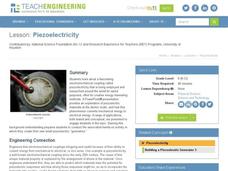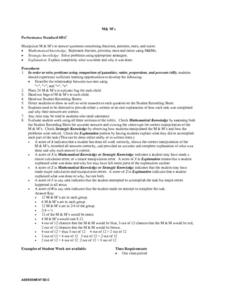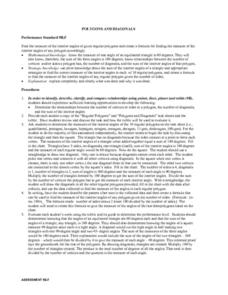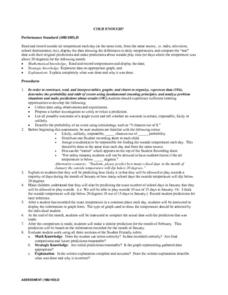Teach Engineering
The Temperature Effect
How temperature affects the efficiency of a solar panel is the focus of the third in a series of eight resources that presents how engineers are able to control the temperatures of photovoltaic panels. Class members find out how the...
Teach Engineering
Maximum Power Point
Investigate the maximum power output of a photovoltaic panel with a lesson that introduces the class to the maximum power point. Individuals learn how to determine the maximum power point of a solar panel by using Ohm's law and the power...
University of Georgia
Density and Texture of Soil
All soil is not created equal! A lab activity asks learners to collect and analyze soil. Specific calculations determine the amount of sand, silt, and clay in a sample and allow individuals to identify the soil texture.
Teach Engineering
Microbes Know How to Work!
Scholars harness the power of microbes with an engaging activity that uses yeast to break down sugar in water. Multiple setups of the same experiment lets learners determine which temperature results in the fastest rate of sugar...
Teach Engineering
Amusement Park Ride: The Ups and Downs in Design
Groups design the ultimate roller coaster by considering potential and kinetic energy. They test their designs using marbles and then go on to rate each group's design based on aesthetics, loop diameter, and cost.
Teach Engineering
Piezoelectricity
What effect makes children's shoes light up? Answer: Piezoelectric effect. Here is a PowerPoint presentation that describes piezoelectric materials as being able to convert mechanical energy to electrical energy. Individuals learn how...
Teach Engineering
News Flash!
Extra, extra, read all about it! Scholars research information on endangered species and produce a news report to share their findings with the rest of the class. In groups, they then consider engineering solutions to problems on habitat...
Curated OER
Exploring Multiplication and Division at a Party
Students solve multiplication and division problems using Unifix cubes. They explore multiplication and division through equal grouping of objects and sharing. Students discuss the task they completed and share how they completed the...
Curated OER
M&M's
Students use M&M candies to show fractions, percents, and ratios. Individually, they complete a worksheet using their candies and solving equations of greater than or less than. They review their answers and strategies used as a...
Curated OER
Shapes Around Us
Students create posters about geometric shapes in order to demonstrate their understanding of the different shapes. Students look for pictures in magazines to represent two-dimensional shapes, paste them on a poster, label the shape,...
Curated OER
Money Bags
First graders identify coins and their value. Using a mixed set of pennies, nickels, dimes, and quarters, they sort the coins and identify the name of each coin and the value of one coin in each set. As the teacher announces a given...
Curated OER
Color Tile Graphing
Students explore data. They gather data and generate questions about the data in pictographs, tallies, tables, and bar graphs. Students use color tiles pulled by random to create their own bar graph. They discuss the bar graphs they...
Curated OER
Estimation Zone
Students explore estimation. They estimate distance, weight, temperature and elapsed time. Students record their estimates and justify their estimations wtih a written response. After estimating, students take the actual measurements of...
Curated OER
Sort it Out
Students identify and sort a variety of two- and three-dimensional objects and compare and contrast their attributes. They identify shapes, locate shapes on the faces of solids, sort real objects and explain the sorting rule, and...
Curated OER
Comparing M&M's
Young scholars sort a bag of M&M's by colors and solve a variety of comparison problems. They determine which pile of M&M's has the most, the least, and answer questions comparing two piles. Students also order the piles of...
Curated OER
Polygons and Diagonals
Students practice measuring the interior angles of given regular polygons and create a formula for finding the measure of th interior angles of any polygon. They determine the relationships between the number of vertices's or sides in a...
Curated OER
No Bias Allowed
Students differentiate graphical representations looking for the bias. They use a systematic process in order to solve problems. Students explain how a problem is solved and the steps involved. Even deeper than this is giving the...
Curated OER
Box And Whiskers
Learners investigate the concept of using box and whisker plots. They demonstrate how to use them to compute median, mode, and range. Students compare and contrast the complete and systematic processes use to solve problems. This is done...
Curated OER
U.S. Customary and Metric Conversions
Students convert U.S. customary measurements into larger or smaller units with the help of conversion charts. They are explained that they are going to use conversion charts in problem solving situations. Pupils use a calculator to...
Curated OER
Cold Enough?
Students read and record temperatures and display the data. They represent the temperatures on an appropriate graph and explain completely what was done and why it was done. Students display the data showing differences in the daily...
Curated OER
Complete The Pattern
Students are introduced to various geometric and numeric patterns. In groups, they work together to determine the next object or number in the pattern. They record their answers on a worksheet and create their own pattern to give to a...
Curated OER
Organizing And Reading Data
Students complete three parts of an "Organizning and Reading Data" worksheet. First, they go over the rubric to determine the work will be scored. They organize data by taking tallies, make a pictograph and a bar graph using the data....
Curated OER
Incomplete Plans
Students practice constructing a building utilizing snap cubes and an incomplete building plan and draw the missing view. They identify and compare relationships in two and three-dimensional representations/objects. Each student explains...
Curated OER
Seesaw Balances
Learners determine how the weights of 7 objects on a seesaw can vary and still be in balance. They also write equations in algebraic terms, how to change 3 variables in an equation expressed in algebraic terms to obtain the correct...

























